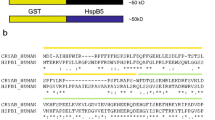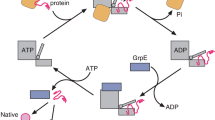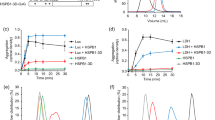Abstract
Human αB-crystallin (HSPB5) is frequently modified post-translationally by UV radiation, oxidation, and age-associated processes, which complicates functional analyses of the protein using natural sources. Thus, determining the biological function of HSPB5 at the molecular structure level requires unmodified protein. Here, we employed an Escherichia coli cell-free protein synthesis system to prepare unmodified, functionally active human HSPB5. An S30 extract prepared from E. coli strain BL21 (DE3) was used for HSPB5 synthesis. The efficacy of protein synthesis was assessed by monitoring influencing factors, such as the concentrations of Mg2+ and other reaction mixture constituents, and by evaluating batch and/or dialysis synthesis systems. Chaperone-like activity of synthesized HSPB5 was assayed using alcohol dehydrogenase (ADH) under thermal stress. The amount of HSPB5 synthesized using the cell-free system depended significantly on the concentration of Mg2+ in the reaction mixture. Use of condensed S30 extract and increased levels of amino acids promoted HSPB5 production. Compared with the batch system, HSPB5 synthesis was markedly increased using the dialysis system. The construction vector played a critical role in regulating the efficacy of protein synthesis. HSPB5 synthesized using the cell-free system had a native molecular mass, as determined by mass spectrometry analysis. The co-presence of synthesized HSPB5 suppressed heat-associated denaturation of ADH. Human HSPB5 synthesized using the cell-free system thus retains functional activity as a molecular chaperone.






Similar content being viewed by others
Change history
18 February 2020
In the original publication, the given name of the last author was incorrectly displayed as the name must read: Katsuyoshi Masuda.
References
Adachi J, Katsura K, Seki E, Takemoto C, Shirouzu M, Terada T, Mukai T, Sakamoto K, Yokoyama S (2019) Cell-free protein synthesis using S30 extracts from escherichia coli RFzero strains for efficient incorporation of non-natural amino acids into proteins. Int J Mol Sci 20:E492. https://doi.org/10.3390/ijms20030492
Arata Y, Kato K, Takahashi H, Shimada I (1994) Nuclear magnetic resonance study of antibodies: a multinuclear approach. Methods Enzymol 239:440–464
Arbach H, Butler C, McMenimen KA (2017) Chaperone activity of human small heat shock protein-GST fusion proteins. Cell Stress Chaperones 22:503–515. https://doi.org/10.1007/s12192-017-0764-2
Atkins JF, Lewis JB, Anderson CW, Gesteland RF (1975) Enhanced differential synthesis of proteins in a mammalian cell-free system by addition of polyamines. J Biol Chem 250:5688–5695
Atomi Y, Yamada S, Strohman R, Nonomura Y (1991) Alpha B-crystallin in skeletal muscle: purification and localization. J Biochem (Tokyo) 110:812–822
Bagnéris C, Bateman OA, Naylor CE, Cronin N, Boelens WC, Keep NH, Slingsby C (2009) Crystal structures of alpha-crystallin domain dimers of alphaB-crystallin and Hsp20. J Mol Biol 392:1242–1252. https://doi.org/10.1016/j.jmb.2009.07.069
Bhat SP (2004) Transparency and non-refractive functions of crystallins-a proposal. Exp Eye Res 79:809–816
Clark AR, Naylor CE, Bagnéris C, Keep NH, Slingsby C (2011) Crystal structure of R120G disease mutant of human αB-crystallin domain dimer shows closure of a groove. J Mol Biol 408:118–134. https://doi.org/10.1016/j.jmb.2011.02.020
Cox D, Selig E, Griffin MD, Carver JA, Ecroyd H (2016) Small heat-shock proteins prevent α-synuclein aggregation via transient interactions and their efficacy is affected by the rate of aggregation. J Biol Chem 291:22618–22629
Davis J, Thompson D, Beckler GS (1996) In vitro transcription/translation-large scale dialysis reactions using E. coli S30 extract systems. Promega Notes Mag 56:14–18
Gangalum RK, Bhat AM, Kohan SA, Bhat SP (2016) Inhibition of the expression of the small heat shock protein αB-crystallin inhibits exosome secretion in human retinal pigment epithelial cells in culture. J Biol Chem 291:12930–12942. https://doi.org/10.1074/jbc.M115.698530
Haslbeck M, Franzmann T, Weinfurtner D, Buchner J (2005) Some like it hot: the structure and function of small heat-shock proteins. Nat Struct Mol Biol 12:842–846
Haslbeck M, Weinkauf S, Buchner J (2019) Small heat shock proteins: Simplicity meets complexity. J Biol Chem 294:2121–2132. https://doi.org/10.1074/jbc.REV118.002809
Head MW, Corbin E, Goldman JE (1993) Overexpression and abnormal modification of the stress proteins αB-crystallin and HSP27 in Alexander disease. Am J Pathol 143:1743–1753
Hochberg GK, Ecroyd H, Liu C, Cox D, Cascio D, Sawaya MR, Collier MP, Stroud J, Carver JA, Baldwin AJ, Robinson CV, Eisenberg DS, Benesch JL, Laganowsky A (2014) The structured core domain of αB-crystallin can prevent amyloid fibrillation and associated toxicity. Proc Natl Acad Sci U S A 111:E1562–E1570. https://doi.org/10.1073/pnas.1322673111
Hoffmann B, Löhr F, Laguerre A, Bernhard F, Dötsch V (2018) Protein labeling strategies for liquid-state NMR spectroscopy using cell-free synthesis.Prog Nucl Magn Reson. Spectrosc 105:1–22. https://doi.org/10.1016/j.pnmrs.2017.11.004
Hohsaka T, Ashizuka Y, Murakami H, Sisido M (1996) Incorporation of nonnatural amino acids into streptavidin through in vitro frame-shift suppression. J Am Chem Soc 118:9778–9779. https://doi.org/10.1021/ja9614225
Hong Y, Zhao T, Li XJ, Li S (2017) Mutant huntingtin inhibits αB-crystallin expression and impairs exosome secretion from astrocytes. J Neurosci 37:9550–9563. https://doi.org/10.1523/JNEUROSCI.1418-17.2017
Horwitz J (1992) α-Crystallin can function as a molecular chaperone. Proc Natl Acad Sci U S A 89:10449–10453. https://doi.org/10.1073/pnas.89.21.10449
Horwitz J (2003) Alpha-crystallin. Exp Eye Res 76:145–153. https://doi.org/10.1016/S0014-4835(02)00278-6
Igarashi K, Matsuo Y, Mitsui K, Hirose S (1980) Effect of polypeptide initiation factors on the spermidine stimulation of initiation complex formation. Biochem Biophys Res Commun 93:360–368. https://doi.org/10.1016/0006-291x(80)91085-2
Iwaki T, Kume-Iwaki A, Liem RK, Goldman JE (1989) αB-crystallin is expressed in non-lenticular tissues and accumulates in Alexander's disease brain. Cell 57:71–78. https://doi.org/10.1016/0092-8674(89)90173-6
Jackson M, Gentleman S, Lennox G, Ward L, Gray T, Randall K, Morrell K, Lowe J (1995) The cortical neuritic pathology of Huntington's disease. Neuropathol Appl Neurobiol 21:18–26
Jehle S, Rajagopal P, Bardiaux B, Markovic S, Kühne R, Stout JR, Higman VA, Klevit RE, van Rossum BJ, Oschkinat H (2010) Solid-state NMR and SAXS studies provide a structural basis for the activation of alphaB-crystallin oligomers. Nat Struct Mol Biol 17:1037–1042. https://doi.org/10.1038/nsmb.1891
Jehle S, Vollmar BS, Bardiaux B, Dove KK, Rajagopal P, Gonen T, Oschkinat H, Klevit RE (2011) N-terminal domain of alphaB-crystallin provides a conformational switch for multimerization and structural heterogeneity. Proc Natl Acad Sci U S A 108:6409–6414. https://doi.org/10.1073/pnas.1014656108
Jovcevski B, Andrew Aquilina J, Benesch JLP, Ecroyd H (2018) The influence of the N-terminal region proximal to the core domain on the assembly and chaperone activity of αB-crystallin. Cell Stress Chaperones 23:827–836. https://doi.org/10.1007/s12192-018-0889-y
Kanda T, Takai K, Yokoyama S, Takaku H (2000) An easy cell-free protein synthesis system dependent on the addition of crude Escherichia coli tRNA. J Biochem (Tokyo) 127:37–41. https://doi.org/10.1093/oxfordjournals.jbchem.a022581
Kang SH, Kim DM, Kim HJ, Jun SY, Lee KY, Kim HJ (2005) Cell-free production of aggregation-prone proteins in soluble and active forms. Biotechnol Prog 21:1412–1419. https://doi.org/10.1021/bp050087y
Kato S, Hirano A, Umahara T, Llena JF, Herz F, Ohama E (1992) Ultrastructural and immunohistochemical studies on ballooned cortical neurons in Creutzfeldt-Jakob disease: expression of αB-crystallin, ubiquitin and stress-response protein 27. Acta Neuropathol (Berl) 84:443–448. https://doi.org/10.1007/bf00227673
Kigawa T (2017) Advances in stable isotope assisted labeling strategies with information science. Arch Biochem Biophys 628:17–23. https://doi.org/10.1016/j.abb.2017.06.014
Kigawa T, Yabuki T, Yoshida Y, Tsutsui M, Ito Y, Shibata T, Yokoyama S (1999) Cell-free production and stable-isotope labeling of milligram quantities of proteins. FEBS Lett 442:15–19. https://doi.org/10.1016/s0014-5793(98)01620-2
Kigawa T, Yamaguchi-Nunokawa E, Kodama K, Matsuda T, Yabuki T, Matsuda N, Ishitani R, Nureki O, Yokoyama S (2002) Selenomethionine incorporation into a protein by cell-free synthesis. J Struct Funct Genom 2:29–35
Kim DM, Swartz JR (1999) Prolonging cell-free protein synthesis with a novel ATP regeneration system. Biotechnol Bioeng 66:180–188
Kim DM, Swartz JR (2000) Prolonging cell-free protein synthesis by selective reagent additions. Biotechnol Prog 16:385–390. https://doi.org/10.1021/bp000031y
Kim DM, Swartz JR (2001) Regeneration of adenosine triphosphate from glycolytic intermediates for cell-free protein synthesis. Biotechnol Bioeng 74:309–316
Kim DM, Kigawa T, Choi CY, Yokoyama S (1996) A highly efficient cell-free protein synthesis system from Escherichia coli. Eur J Biochem 239:881–886. https://doi.org/10.1111/j.1432-1033.1996.0881u.x
Krinsky N, Kaduri M, Shainsky-Roitman J, Goldfeder M, Ivanir E, Benhar I, Shoham Y, Schroeder A (2016) A simple and rapid method for preparing a cell-free bacterial lysate for proteinsynthesis. PLoS One 11:e0165137. https://doi.org/10.1371/journal.pone.0165137
Kwon YC, Jewett MC (2015) High-throughput preparation methods of crude extract for robust cell-free protein synthesis. Sci Rep 5:8663. https://doi.org/10.1038/srep08663
Liu Z, Wang C, Li Y, Zhao C, Li T, Li D, Zhang S, Liu C (2018) Mechanistic insights into the switch of αB-crystallin chaperone activity and self-multimerization. J Biol Chem 293:14880–14890. https://doi.org/10.1074/jbc.RA118.004034
Longoni S, James P, Chiesi M (1990) Cardiac alpha-crystallin. I. Isolation and identification. Mol Cell Biochem 99:113–120
Miesbauer LR, Zhou X, Yang Z, Yang Z, Sun Y, Smith DL, Smith JB (1994) Post-translational modifications of water-soluble human lens crystallins from young adults. J Biol Chem 269:12494–12502
Mogk A, Bukau B (2017) Role of sHsps in organizing cytosolic protein aggregation and disaggregation. Cell Stress Cheperones 22:493–502. https://doi.org/10.1007/s12192-017-0762-4
Mukai T, Hoshi H, Ohtake K, Takahashi M, Yamaguchi A, Hayashi A, Yokoyama S, Sakamoto K (2015) Highly reproductive Escherichia coli cells with no specific assignment to the UAG codon. Sci Rep 5:9699. https://doi.org/10.1038/srep09699
van Noort JM, van Sechel AC, Bajramovic JJ, el Ouagmiri M, Polman CH, Lassmann H, Ravid R (1995) The small heat-shock protein αB-crystallin as candidate autoantigen in multiple sclerosis. Nature 375(6534):798–801. https://doi.org/10.1038/375798a0
Numoto N, Kita A, Fujii N, Miki K (2012) A P39R mutation at the N-terminal domain of human αB-crystallin regulates its oligomeric state and chaperone-like activity. Biochem Biophys Res Commun 425:601–606. https://doi.org/10.1016/j.bbrc.2012.07.138
Pasta SY, Raman B, Ramakrishna T, Rao CM (2004) The IXI/V motif in the C-terminal extension of alpha-crystallins: alternative interactions and oligomeric assemblies. Mol Vis 10:655–662
Peschek J, Braun N, Rohrberg J, Back KC, Kriehuber T, Kastenmüller A, Weinkauf S, Buchner J (2013) Regulated structural transitions unleash the chaperone activity of αB-crystallin. Proc Natl Acad Sci U S A 110:E3780–E3789. https://doi.org/10.1073/pnas.1308898110
Pratt JM (1984) Coupled transcription-translation in prokaryotic cell-free systems. In: Hames BD, Higgins SJ (eds) transcription and translation. IRL press, Oxford, pp 179–209
Rahn A, Whitfield C (2003) Transcriptional organization and regulation of the Escherichia coli K30 group 1 capsule biosynthesis (cps) gene cluster. Mol Microbiol 47:1045–1060. https://doi.org/10.1046/j.1365-2958.2003.03354.x
Shatov VM, Weeks SD, Strelkov SV, Gusev NB (2018) The role of the arginine in the conserved N-terminal domain RLFDQxFG motif of human small heat shock proteins HspB1, HspB4, HspB5, HspB6, and HspB8. Int J Mol Sci 19:E2112. https://doi.org/10.3390/ijms19072112
Spirin AS (2004) High-throughput cell-free systems for synthesis of functionally active proteins. Trends Biotechnol 22:538–545. https://doi.org/10.1016/j.tibtech.2004.08.012
Spirin AS, Baranov VI, Ryabova LA, Ovodov SY, Alakhov YB (1988) A continuous cell-free translation system capable of producing polypeptides in high yield. Science 242:1162–1164. https://doi.org/10.1126/science.3055301
Sreelakshmi Y, Sharma KK (2006) The interaction between αA- and αB-crystallin is sequence-specific. Mol Vis 12:581–587
Srivastava OP, Srivastava K, Silney C (1994) Identification of origin of two polypeptides of 4 and 5 kD isolated from human lenses. Invest Ophthalmol Vis Sci 35:207–214
Stoevring B, Vang O, Christiansen M (2005) (α)B-crystallin in cerebrospinal fluid of patients with multiple sclerosis. Clin Chim Acta 356:95–101. https://doi.org/10.1016/j.cccn.2005.01.034
Terada T, Yokoyama S (2015) Escherichia coli cell-free protein synthesis and isotope labeling of mammalian proteins. Methods Enzymol 565:311–345. https://doi.org/10.1016/bs.mie.2015.08.035
Thornell E, Aquilina A (2015) Regulation of αA- and αB-crystallins via phospho-rylation in cellular homeostasis. Cell Mol Life Sci 72:4127–4437. https://doi.org/10.1007/s00018-015-1996-x
Treweek TM, Ecroyd H, Williams DM, Meehan S, Carver JA, Walker MJ (2007) Site-directed mutations in the C-terminal extension of human alphaB-crystallin affect chaperone function and block amyloid fibril formation. PLoS One e1046:1–10. https://doi.org/10.1371/journal.pone.0001046
Treweek TM, Rekas A, Walker MJ, Carver JA (2010) A quantitative NMR spectroscopic examination of the flexibility of the C-terminal extensions of the molecular chaperones, αA- and αB-crystallin. Exp Eye Res 91:691–699. https://doi.org/10.1016/j.exer.2010.08.015
Yabuki T, Kigawa T, Dohmae N, Takio K, Terada T, Ito Y, Laue ED, Cooper JA, Kainosho M, Yokoyama S (1998) Dual amino acid-selective and site-directed stable-isotope labeling of the human c-Ha-Ras protein by cell-free synthesis. J Biomol NMR 11:295–306
Acknowledgment
We thank Mr. Hidetoshi Kamijyo for technical support.
Funding
This work was supported in part by a grant from Meijo University Research Institute (Grant-in-Aid for Specially Promoted Research).
Author information
Authors and Affiliations
Corresponding author
Additional information
Publisher’s note
Springer Nature remains neutral with regard to jurisdictional claims in published maps and institutional affiliations.
Rights and permissions
About this article
Cite this article
Kojima, R., Uchiya, K., Manshio, H. et al. Cell-free synthesis of functionally active HSPB5. Cell Stress and Chaperones 25, 287–301 (2020). https://doi.org/10.1007/s12192-020-01073-5
Received:
Revised:
Accepted:
Published:
Issue Date:
DOI: https://doi.org/10.1007/s12192-020-01073-5




